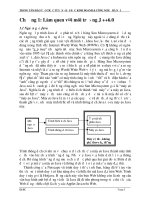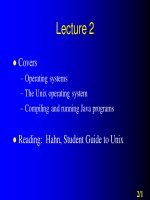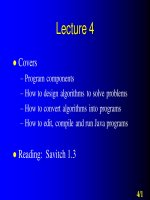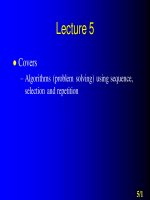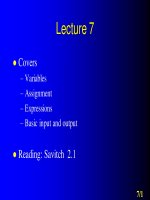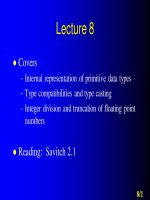Giáo trình Java cơ bản 23
Bạn đang xem bản rút gọn của tài liệu. Xem và tải ngay bản đầy đủ của tài liệu tại đây (372.53 KB, 39 trang )
Lecture 23
Covers
–
–
–
–
–
Designing methods
Procedural abstraction, top-down design
Drivers and stubs
Testing
Formatting decimal output
Reading: Savitch 5.3
23/1
Lecture outline
Top-down decomposition (or, procedural
abstraction)
Testing strategies
DecimalFormat class
23/2
Top-down Decomposition
There are two basic techniques for
developing complex methods:
– Divide a complex task into a number of
subtasks (divide the subtasks again if
necessary)
– Using methods to program the subtasks
We may use the term “procedure
abstraction” to refer to such an approach.
A more commonly used term is “top-down
decomposition”
23/3
Testing strategies
Category testing: Test values in each
category of input
Boundary value testing: Test boundary
values
Unit testing: Test each method separately
Integration testing: Test how the methods
act together
23/4
Stubs
In early phases of integration testing, we
may use stubs for proper methods
Stubs are methods that are not correctly
coded
– They have proper signatures. So they can be
called in integration tests. But they may yield
the wrong results as their body is incomplete.
23/5
Drivers
Sometimes we write small programs in
order to test particular methods or classes
during the development process
Such programs are referred to as driver
programs (or drivers)
23/6
What is procedural
abstraction?
Use methods to progressively refine a problem
Each method can then be treated as a “black
box”
input
input
method
result
23/7
What is procedural
abstraction?
All the programmer needs to know to use
the method is the method’s header and a
description of the processing of the method
They do not need to know any of the details
contained in this “black box”
23/8
Example
Write a program that reads a value from the
user and outputs the square root of the value
entered (without using the sqrt method in
the Math class)
Use Heron’s method for approximating the
square root
23/9
Example
Main steps
Prompt user to enter a number
Get input
Calculate Square root
Display result
23/10
Example
Refinement of calculate square root method
METHOD calculateSquareRoot(in:num, out: sqrt)
Guess at sqrt
DO
Average guess and num/guess as better guess
Calculate square of guess
WHILE (square of guess is not close enough to num)
Return guess
ENDMETHOD
23/11
Example
public class SqrtProgram
{
public static double calculateSquareRoot(double num)
{
double guess = Math.random( ) * num;
double squareOfGuess;
do
{
guess = (guess + num/guess) / 2;
squareOfGuess = guess * guess;
}
while (Math.abs(squareOfGuess - num) > 0.0001);
return guess;
}
23/12
Example
public static void main(String[ ] args)
{
Scanner keyboard = new Scanner(System.in);
System.out.print("Enter a number whose "
"square root you require: ");
double num = keyboard.nextDouble( );
double sqrtOfNum = calculateSquareRoot(num);
System.out.print("The square root of the number is "
+ sqrtOfNum);
}
}
23/13
Testing strategies
Test each category of input
Test boundary values
Test each method in the program separately
23/14
Testing categories of input
Decide what kinds of values are to be dealt
with and test each category
public static void main(String[ ] args)
{
int value;
Scanner keyboard = new Scanner(System.in);
System.out.print("Input an integer value: ");
value = keyboard.nextInt( );
if (value > 0)
Positive numbers, e.g. 3
System.out.println(value + " is a positive number");
else
Negative numbers, e.g. -5
System.out.println(value + " is a negative number");
}
23/15
Testing boundary values
An input value is a boundary value if it is a
value at which the program changes behaviour
public static void main(String[ ] args)
{
Scanner keyboard = new Scanner(System.in);
int value;
System.out.print("Input an integer value: ");
value = keyboard.nextInt( );
Boundary value 0
if (value >= 0)
(Test -1, 0, 1)
System.out.println(value + " is a positive number");
else
System.out.println(value + " is a negative number");
}
23/16
Testing and debugging
methods
Top down design translates one big problem
into a series of smaller, more manageable
methods
Each method should be designed, coded and
tested as a separate unit from the rest of the
program
How do we test a method outside the
program for which it is intended?
– Write a driver program
23/17
Testing and debugging
methods
By testing each method separately, locating
the mistakes in the program is much easier
A fully tested method can be used in a
driver program for another method
Sometimes to test a method, we must use
another method that has not been written yet
Use a simplified version of the missing or
untested method called a stub
23/18
Case study
Write a program that tells the user what coins are
needed to give any amount of change from 1 cent
to 99 cents
For example if the amount is 85 cents, the output
would be
85 Cents can be given as
1 fifty-cent(s), 1 twenty-cent(s), 1 ten-cent(s), and 1 five-cent(s)
23/19
Case study
Main Steps
Get amount
Round to the nearest 5 cents
Calculate number of fifty-cents
Calculate number of twenty-cents
Calculate number of ten-cents
Calculate number of five-cents
Output the results to screen
23/20
Case study
Refinement of Get amount
DO
Prompt user for input
Get value from user
IF (1 input 99) THEN
valid is true
ELSE
valid is false
Output error message
ENDIF
WHILE not valid
23/21
Case study
private static int getAmount( )
{
int value;
boolean valid;
do
{
System.out.print("Enter change amount: ");
value = keyboard.nextInt( );
if ((value >= 1) && (value <= 99))
{
valid = true;
}
else
{
valid = false;
System.out.println("Number must be between 1 and 99");
}
} while(valid == false);
return value;
23/22
}
Case study
// Driver for the getAmount method
public static void main(String[ ] args)
{
int changeAmount;
String againString = “”;
char again;
do
{
changeAmount = getAmount( );
System.out.println("The amount entered was: " + changeAmount);
System.out.print("Again? ");
againString = keyboard.nextLine( );
again = againString.charAt(0);
} while ((again == 'y') || (again == 'Y'));
}
23/23
Case study
Enter change amount: 44
The amount entered was: 44
Again? y
Enter change amount: 1
The amount entered was: 1
Again? y
Enter change amount: 0
Number must be between 1 and 99
Enter change amount: 2
The amount entered was: 2
Again? y
Enter change amount: 99
The amount entered was: 99
Again? y
Enter change amount: 100
Number must be between 1 and 99
Enter change amount: 98
The amount entered was: 98
Again? n
Category
test
Lower
boundary
test
Upper
boundary
test
23/24
Case study
Refinement of Round to nearest 5 cents
remainder = changeAmount % 5;
IF (remainder equals 1 or 2) THEN
Subtract remainder from changeAmount
ELSE
IF (remainder equals 3 or 4) THEN
Add (5 - remainder) to changeAmount
ENDIF
ENDIF
23/25


